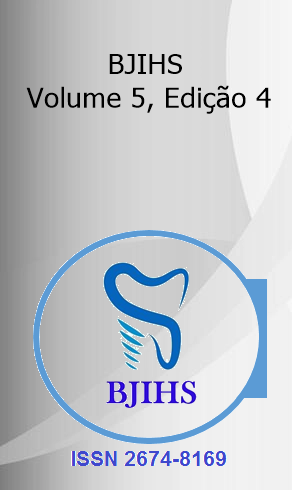Abstract
In pharmaceutical industry it is possible to find some liquid medicines that presentes a distasteful flavor, there is need to mix many sweeteners in the same product to become it with a tasteful flavor, specially when used in pediatric patient. This study presents as main objective to identifythe kind of used sweeteners into pediatric antibitiotic composition. This is a quantitative and retrospective study and performed by bulla’s reading of four pediatric antibiotics and to reach this, a data base survey on Scielo, Lilacs and PubMed, books, masters and doctorate theses. It is verified that the pediatric antibiotics contain many excipients, specially the sweeteners, that presents a direct relationship with children oral conditions. All analyzed medicines contain some type of sweetener – essentially the sucrose.
References
Marquezan M et al. Medicamentos utilizados por pacientes odontopediátricos e seu potencial cariogênico. Rev. Pós Grad. 2007; 13 (4): 334-339.
Xavier AFC, Cavalcanti AL, Oliveira MC, Vieira FF. Antibióticos líquidos de uso pediátrico: caracterização físico-química. HU Rev. 2011; 37 (4): 397-401.
Pierro VSS et al. Free sugar concentration and pH of pediatric medicines in Brazil. Com. Dent. Health. 2005; 22 (3): 180-183.
Balbani APS, Stelzer LB, Montovani JC. Excipientes de medicamentos e as informações da bula. Rev. Bras. Otorrinolaringol. 2006; 72 (3): 400-406.
Oliveira PG, Storpirtis S. Toxicidade de excipientes: carência de informação nas bulas de medicamentos disponíveis no mercado brasileiro. Rev. Bras. Ciênc. Farm. 2005; 35 (1): 71.
Wangberg SC, Andreassen HK, Prokosch HU, Santana SM, Sorensen T, Chronaki CE. Relations between Internet use, Socio-Economic Status (SES), social support and subjective health. Health Promot. Int. 2008; 23 (5): 70-77.
Soni MG, Burdock GA, Taylor SL, Greenberg NA. Safety assessment of propylparaben: a review of the published literature. Food Chem. Tox. 2001; 39 (2): 513-532.
Lima KT, Almeida ICS, Senna ETL. Medicamentos pediátricos – agentes edulcorantes e pH. J. Bras. Odontoped. Odontol. Bebê. 2000 3 (16): 104-110.
Selwitz RH, Ismail AI, Pitts NB. Dental caries. Lancet. 2007; 369 (2): 51-59.
Passos I, Freitas C, Sampaio F. Potêncial cariogênico de medicamentos pediátricos – papel na etiologia da cárie dentária. Rev. Inst. Ciênc. Saúd. 2008; 26 (2): 125-129.
Robertson MI. Regulatory issues with excipients. Int. J. Pharm. 2002; 187 (3): 273-276.
Katzung BG. Farmacologia básica e clínica. 9. ed. Rio de Janeiro: Guanabara Koogan, 2005.
Rowe RC. Handbook of pharmaceutical excipients. 3. ed. London: Pharmaceutical Press, 2000.
Committee for medicinal products for human use. Reflection paper: formulations of choice for the pediatric population. London: European Medicines Agency, 2006.
Peres KG, Oliveira CT, Peres MA. Sugar content in liquid oral medicines for children. Rev. Saúd. Púb. 2005; 39 (3): 486-489.
Neves BG, Pierro VSS, Maia LC. Percepções e atitudes de responsáveis por crianças frente ao uso de medicamentos infantis e sua relação com cárie e erosão dentária. Ciênc. Saúd. Col. 2007; 12 (5): 1295-1300.
Neiva A, Silva VSD, Maia LC, Soares EL, Trugo LC. Análise in vitro da concentração de sacarose e pH de antibacterianos de uso pediátrico. Pesq. Bras. Odontoped. Clin. Integr. 2001; 1 (2): 9-16.
Costa CC, Almeida IC, Raiymundo MS, Fett R. Análise do pH endógeno, da acidez e da concentração de sacarose de medicamentos pediátricos. Rev. Odonto. Ciênc. 2004; 19 (3): 164-169.
Ferreira RCS, Yoshimatsu GS, Duarte LF, Sato LV, Gonçalves RFF. Bulário explicativo. 2. ed. São Paulo: Rideel, 2015.
Bigeard L. The role of medication and sugars in pediatric dental patients. Dent. Clinic. Nor. Americ. 2000; 44 (2): 443-456.
Fuchs FD, Wannmacher L, Ferreira MBC. Farmacologia clínica: fundamentos da terapêutica racional. 3. ed. Rio de Janeiro: Guanabara Koogan, 2004.
Massoni A, Forte F, Sampaio F. Percepção de pais e responsáveis sobre promoção de saúde bucal. Rev. Odontol. 2005; 34 (2): 193-197.
Medicina Net [homepage na internet]. Bulas dos medicamentos. [acesso em 27 set. 2016]. Disponível em: www.medicinanet.com.br.
Douglass JM, Douglass AB, Silk HJ. A practical guide to infant oral health. Am. Farm. Physician. 2004; 70 (1): 2113-2120.
Nunn JH. The burden of oral ill health for children. Arch. Dis. Child. 2006; 91 (2): 251-253.
Pierro VS, Barcelos R, Maia LC, Silva AN. Pediatrician´s perception about the use of antibiotics and dental caries: a preliminary study. J. Public. Health. Dent. 2004; 64 (1): 244-248.
Neves BG, Pierro VS, Maia LC. Pediatrician´s perception of the use of sweetened medications related to oral health. J. Clin. Pediatr. Dent. 2008; 32 (3): 133-137.
Hebling J, Teixeira HM, Pizzolito AC. Potencial cariogênico de medicamentos infantis. Rev. Odontol. do Bras. Centr. 2002; 11 (31): 35-39.
Menezes VA. Pediatric medicines and their relationship to dental caries. Braz. J. Pharma. Scienc. 2010; 46 (1): 157-164.
Babu KL, Rai K, Hedge AM. Pediatric liquid medicaments: do they erode the teeth surface: an in vitro study: part I. J. Clinic. Pediat. Dent. 2008; 32 (3): 189-194.
Sebastian G, Ciancio DDS. Medication´s impact on oral health. J. Americ. Dent. Associat. 2004; 135 (10): 1440-1448.
Passos IA, Freitas CHSM, Sampaio FC. Fluoride concentration and pH of pediatric medicines regulary and longterm used by children. Med. Oral. Patolog. Oral. y Cirurg. Buc. 2011; 16 (3): 459-462.

This work is licensed under a Creative Commons Attribution 4.0 International License.
Copyright (c) 2023 Djalma Antonio de Lima Júnior, Ellen Angélica Ferreira Dias, Luciana Coelho Ferreira, Talyta Cristina Santos de Azevedo

